Ultra-High-Pressure Forged Self-Sealing Pre-Start Control Valve
Ultra-High-Pressure Forged Self-Sealing Pre-Start Control Valve
Dec 16, 2024
This report presents an ultra-high-pressure forged pre-start multi-stage adjustable self-sealing control valve, focusing on its structural features and operating principles. A comparative analysis of the product structure, manufacturing process, and overall performance was conducted. The design improvements for the steam control valve include integral forgings for pressure-bearing components and a multi-stage sleeve with a pre-start auxiliary valve core, featuring an adjustable self-sealing balanced pressure reduction structure. This design enhances the valve’s efficiency and performance.
In response to national initiatives for energy conservation, emission reduction, and industrial transformation, the steam control valve plays a critical role in steam turbine bypass systems and temperature/pressure reduction devices. It is widely used in industries such as power generation, petrochemicals, textiles, heating, refrigeration, large-scale cogeneration, and military vessels. The valve directly influences the performance of steam turbine bypass systems and temperature/pressure reduction devices. Traditional steam control valves are prone to damage and vibration, often leading to leakage. The increasing variability in large-scale operating conditions and complex process parameters often causes issues with regulation, safety, and reliability in these systems. This report introduces a super-high-pressure pre-start multi-stage adjustable self-sealing balanced pressure reduction forged control valve. The valve features significant improvements in structure, manufacturing technology, reliability, and cost efficiency, and is specifically designed to meet the demands of large-scale, variable operating conditions and complex process parameters.
Figure 1 illustrates the composition of the ultra-high-pressure forged pre-start multi-stage adjustable self-sealing control valve. The design of this valve integrates multi-stage pressure reduction and noise attenuation, combined with a cage sleeve structure and both main and auxiliary valve cores. This enables efficient multi-stage pressure reduction with a pressure reduction ratio as low as 0.3, achieving a precision of 1% under ultra-high temperature, high-pressure, and significant pressure differential conditions.
The valve body and bonnet are forged from high-temperature, high-pressure-resistant materials, ensuring a uniform, dense structure, enhanced structural integrity, and superior reliability under extreme operating conditions. Additionally, the forged valve body is available in various configurations, including straight-through (flat-in/flat-out), top-entry/bottom-exit, and angled types, to meet specific installation requirements. Its compact design and efficient layout reduce space requirements and installation costs.
A metal-elastic Wood seal structure is used between the valve body and bonnet, ensuring a secure connection and enhancing the seal's lifespan and reliability under ultra-high-pressure conditions. The sleeve and valve core feature a high-efficiency cage sleeve structure. Compared to traditional plunger control valves, this design offers superior noise reduction and pressure attenuation. Optimal internal component alignment and precision manufacturing technology regulate the outlet steam flow rate, mitigate cavitation risk, and minimize noise and vibration during operation. Under high-temperature, high-pressure conditions, the valve operates with minimal vibration, and the overall noise level remains below 85 dB(A). Figure 4 illustrates the theoretical simulation results for vibration and noise reduction.
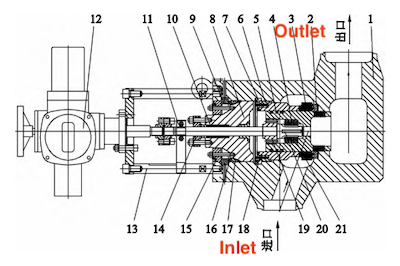
1. Valve body 2. Valve seat 3. Multi-stage sleeve 4. Main valve core 5. Carbon ring seal 6. Lower positioning ring 7. Lower four-opening and closing ring 8. Valve bonnet 9. Upper four-opening and closing ring 10. Sealing packing 11. Guide frame 12. Actuator 13. Insulation frame 14. Packing pressure plate 15. Support plate 16. Gasket 17. Wood seal pair 18. Fastening butterfly nail 19. Balance hole seat 20. Pre-start auxiliary valve core 21. Disc spring
Figure 1 Ultra-high pressure forged self-sealing pre-start multi-stage adjustable control valve
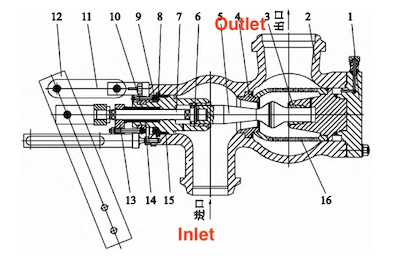
1. Lower valve bonnet 2. Valve body 3. Lower guide bushing 4. Valve seat 5. Valve core 6. Pin shaft 7. Valve stem 8. Four-opening and closing ring 9. Support plate 10. Clamp 11. Clamp plate 12. Lever 13. Packing pressure plate 14. Sealing packing 15. Sealing ring 16. Throttle screen
Figure 2 Traditional self-sealing high-pressure control valve
The sleeve, valve core, and other components are made from Cr-Mo-V or Cr-W-V alloys, which exhibit outstanding resistance to both high temperatures and high pressures. Advanced processing techniques are employed to significantly enhance surface hardness, improving the valve's operational stability and extending its service life.
The valve stem is made from imported high-chromium, heat-resistant stainless steel, which prevents electrochemical reactions with graphite packing, thereby avoiding corrosion and surface pitting. Additionally, the surface undergoes an electrostrictive metal finishing process to enhance hardness and surface smoothness, thereby reducing friction and minimizing leakage.
The pre-start auxiliary valve core incorporates advanced technology, enabling precise control during operation. During valve operation, the auxiliary valve core opens first, followed by the main valve core once pressure equilibrium is achieved. This process effectively reduces unbalanced forces during operation, lowering actuator shaft thrust, minimizing energy consumption, and improving the cost-effectiveness of the control valve. Figure 5 illustrates the design principle.
The control valve seal is designed for zero leakage, with the sealing surface coated with an imported hard alloy. The single-seat tapered seal pair enhances the resistance to erosion at the valve port, ensuring reliable sealing when the valve is closed. Figure 6 illustrates the design principle.
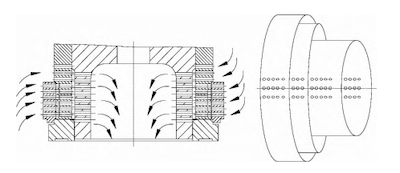
Figure 3 Pressure Reduction Design
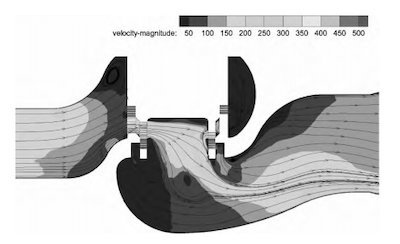
Figure 4 Theoretical Simulation of Vibration and Noise Reduction
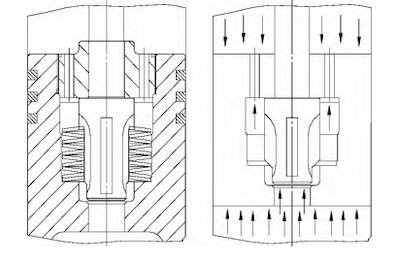
Figure 5 Schematic Diagram of the Pre-Start Auxiliary Valve Core Structure
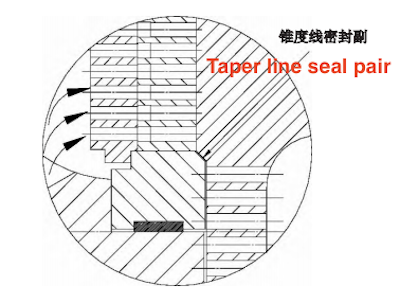
Figure 6 Tapered Seal Pair Diagram of the Valve Core and Valve Seat
The control valve sealing material is made from high-performance reinforced flexible graphite to prevent leakage from the valve stem during operation. Additionally, the sealing ring is constructed from high-quality imported materials, ensuring reliable sealing performance under high-temperature and high-pressure conditions. The valve seat features an inlaid split structure, effectively preventing deformation caused by thermal stress. The valve core and stem are designed as a single integrated unit, which simplifies both disassembly and reassembly, improving on-site maintenance efficiency. All wear parts are replaceable, with an efficient and simplified replacement process.
The valve seat and body are precision-ground before assembly, with a stainless steel sealing gasket installed between them. Three carbon ring seals are used at the dynamic seal between the valve core and sleeve, preventing internal leakage and minimizing the potential for valve body erosion. The valve’s thermal insulation frame incorporates four high-strength steel columns, reducing weight, enhancing vibration resistance, and preventing fatigue-induced cracking of the casting bracket. This structure minimizes heat transfer from the valve body to the actuator, thereby enhancing valve reliability.
The control valve opens, adjusts, or closes in response to a pressure signal applied to the rear of the valve. The signal activates the actuator, which, in turn, drives the valve stem connected to the valve core. As the valve core moves vertically within the valve seat and multi-stage sleeve, it modifies the flow area of the medium, thereby controlling throttling. Inlet steam first passes through the sleeve in the upper chamber, where primary throttling and decompression occur. Secondary throttling and decompression take place at lower flow rates. The steam then flows through the main valve core within the valve seat for further throttling and decompression, followed by tertiary throttling and decompression at even lower flow rates, before entering the lower chamber.
The main valve core is adjusted vertically within the multi-stage sleeve to control the flow area of the first sleeve, thereby achieving primary throttling and decompression. Simultaneously, the main valve core is adjusted within the valve seat to control the number of throttling holes at its lower end, modifying the flow area to achieve secondary throttling and decompression.
All valve materials undergo precision machining, with the inner surfaces of the multi-stage sleeve and valve stem precisely ground to tight tolerances. After grinding, the valve stem undergoes an electrochemical finishing process, improving its corrosion resistance and reducing friction between the stem and packing. Stud holes on the valve body and corresponding holes on the valve cover are machined with high precision to ensure alignment. Before assembly, the valve seat and core are precision ground, and three sets of sealing rings are installed between the valve core and multi-stage sleeve to prevent internal leakage and mitigate the risk of valve body wear. The inner surfaces of the multi-stage sleeve, valve seat, packing pad, and packing gland are nitrided to enhance surface hardness, reduce wear between moving parts, and extend the valve's service life.
In response to the leakage and vibration issues experienced by traditional control valve structures during system operation, the causes of these issues have been analyzed. Based on this analysis, a structural improvement design was developed and verified by multiple users. The high-pressure forged pre-start multi-stage adjustable self-sealing control valve offers a more rational structure and improved adjustment performance, ensuring the reliable operation of the system.
Next: Two Multi-Directional Die Forging Methods for Ball Valve Bodies
Previous: Modular Structure & Design of a Small-Diameter Forged Regulating Valve for LNG Systems